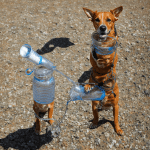When it comes to outdoor activities, we all know the importance of staying well-hydrated, especially during the hot summer months. But did you know the same applies to your furry friends? Just like humans, dogs need a steady supply of water to maintain their health. Dehydration in dogs can lead to serious health complications, so it’s crucial to keep your pet hydrated even while enjoying outdoor activities. This article will provide you with comprehensive guidance on the best practices to ensure your dog stays hydrated and healthy.
Understanding the Importance of Hydration for Your Pets
Before we dive into the best practices, it’s essential to understand why hydration is so important for your dogs. Hydration is more than just quenching thirst. It plays a vital role in the overall health and wellbeing of your pet.
En parallèle : How to Choose the Best Dietary Supplements for Your Pet’s Health Needs?
Firstly, water aids in digestion. It helps break down food, allowing your pet to absorb nutrients effectively. Secondly, it helps regulate body temperature, which is critical during hot summer days. Thirdly, it aids in the removal of waste from the body, ensuring that your pet stays clean and healthy from the inside out.
Dehydration in pets can lead to serious health problems such as kidney and liver disease. Dogs, in particular, can become dehydrated quickly during outdoor activities, as they can lose water rapidly through panting and sweating. Therefore, it’s crucial to ensure your dog gets enough water, especially during active play or exercise.
Dans le meme genre : How to Effectively Use Technology for Pet Training and Monitoring?
Recognizing Signs of Dehydration in Your Dog
Recognizing the signs of dehydration in your dog is crucial in maintaining their health. It can also help you understand when you need to provide additional water and when to seek veterinary attention.
The most common signs of dehydration in dogs include excessive panting and drooling, dry nose and gums, sunken eyes, and lethargy. If your pup appears to be excessively thirsty, it’s likely that they are already dehydrated.
In severe cases of dehydration, you may notice your dog’s skin loses its elasticity. A simple test to check for this is by gently pulling up the skin at the back of your dog’s neck. If it does not immediately spring back to its original position, your dog may be dehydrated.
Ensuring Adequate Water Supply for Your Dog
Ensuring your dog has access to clean, fresh water is the first step to preventing dehydration. The amount of water your dog needs can vary based on their size, age, and activity level. A general rule of thumb is that dogs should have about one ounce of water per pound of body weight per day.
When engaging in outdoor activities, it’s essential to provide additional water to compensate for the water lost through panting and sweating. Carry a portable water bowl or a specially designed pet water bottle during walks or hikes. Offer your dog water at regular intervals, even if they don’t seem thirsty.
Remember, it’s better to provide too much water than not enough. However, be mindful of conditions such as water intoxication, which can occur if your dog drinks too much water too quickly.
Keeping Your Dog Cool to Prevent Dehydration
Keeping your dog cool during hot summer days is another effective way to prevent dehydration. Dogs don’t sweat like humans do, so they rely on panting to cool down. However, panting can lead to water loss and subsequently dehydration.
To keep your dog cool, you can use various methods such as providing shade, using a cooling mat, or even a kiddie pool for your dog to splash around in. You can also wet your dog’s coat with cool – not cold – water to help lower their body temperature.
Remember to avoid strenuous activities during the hottest parts of the day. Instead, opt for early morning or late evening when temperatures are lower.
Integrating Hydrating Foods Into Your Dog’s Diet
Another clever way to ensure your pet stays hydrated is by integrating hydrating foods into their diet. Many fruits and vegetables have high water content and can be an excellent treat for your dog.
Some safe options include watermelon (without seeds or rind), cucumbers, and carrots. You can also consider adding wet food to your dog’s diet, especially during the hotter months. Wet food is typically about 70-80% water, while dry food is only about 10%.
Before introducing any new food into your dog’s diet, it’s always a good idea to consult with your veterinarian. They can provide advice tailored specifically to your pet’s needs and ensure the new food is safe and healthy for your dog.
In conclusion, hydration is an essential component of your dog’s health and wellbeing. By recognizing the signs of dehydration, providing ample water, keeping your dog cool, and integrating hydrating foods into their diet, you can ensure your pet stays hydrated and healthy during outdoor activities.
Monitoring Your Pet’s Water Intake
Observing and managing your pet’s water intake is an integral part of ensuring their hydration. Keep an eye on how much water your dog is drinking, and adjust the amount if needed.
Dogs are individuals and their water needs can vary. Some dogs might drink more than others, which is fine as long as they are not drinking excessively. A sudden increase in your dog’s water intake could indicate a health problem and should be addressed with a veterinarian.
Emptying and refilling your pet’s water bowl regularly is a good habit. This ensures your dog always has access to fresh water. It is also a good practice to clean the water bowl daily to prevent bacterial growth.
In addition to a standard water bowl, you can consider using a pet water fountain. These devices constantly circulate water, keeping it fresh and appealing to your pets. Some dogs prefer moving water and may drink more from a fountain than a still bowl. Remember, the goal is to encourage your pup to drink water.
Finally, always bring a portable water bowl or pet water bottle on walks or hikes. This will ensure your furry friend has access to fresh water during outdoor activities. Dogs can lose water rapidly while panting or sweating, so it’s important to replenish their water supply often.
Utilizing Ice Cubes and Frozen Treats for Hydration
During hot weather, ice cubes and frozen treats can be an excellent way to hydrate your pet. Most dogs enjoy the crunch of ice cubes, making them a fun and hydrating treat. You can even add a few ice cubes to your pet’s water bowl to keep the water cooler for a longer period.
In addition to ice cubes, you can freeze chicken broth or make popsicles out of dog-friendly fruits or yogurt. These frozen treats can provide a refreshing, hydrating snack for your pet during hot summer days.
However, remember to supervise your pet when they are enjoying these treats. While most dogs can safely chew ice cubes, some may try to swallow them whole, which can be a choking hazard.
Keep in mind that although ice cubes and frozen treats can help keep your pet hydrated, they should not replace their regular water intake.
Conclusion
Providing adequate hydration for your pet is essential for their overall health and wellbeing. By understanding the importance of hydration, recognizing the signs of dehydration, monitoring your pet’s water intake, and utilizing methods such as keeping your pet cool, offering hydrating foods, and employing ice cubes and frozen treats, you can ensure your dog stays hydrated, especially during outdoor activities.
Remember that changes in your dog’s water intake can indicate health issues, so always keep an eye on your furry friend’s drinking habits. And while hydration is especially important during the hot summertime, it’s essential to ensure your pet has access to fresh water all year round.
Ultimately, being proactive about your pet’s hydration can prevent health issues and contribute to their longevity and happiness. It is your responsibility to ensure your furry friend stays hydrated and healthy, so always prioritize their hydration needs during outdoor activities and beyond.











